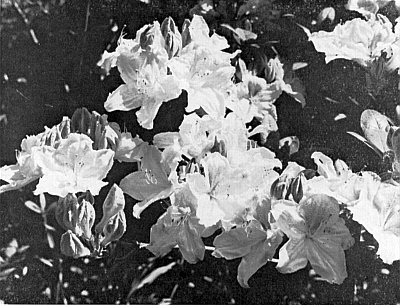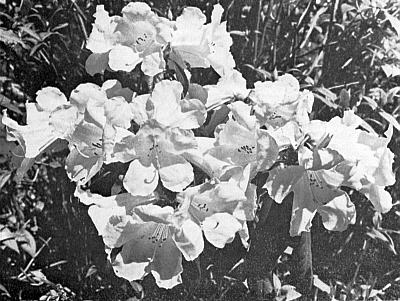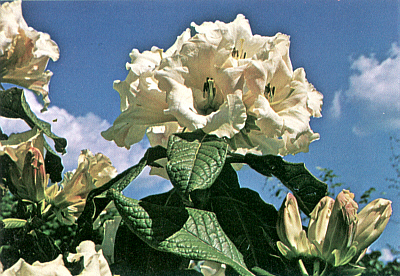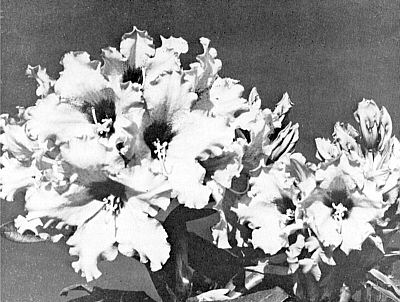Rhododendrons & Climate in the Dandenong Ranges
A. W. Headlam, Bentleigh, Australia
Australia has a vast range of climatic conditions, from tropical in the north where
R. lochiae
, the only rhododendron indigenous to Australia, is found in the mountainous rain forests of North Queensland, to the extremely mild climate of Tasmania, whose southern extremity extends to a latitude of 43° South.
The Dandenong Ranges, which lie some 25 miles east of Melbourne have undoubtedly the greatest concentration of rhododendrons in Australia. Covering an area of 150 square miles, they contain a number of National Parks and Forest Reserves, and quite appropriately are the home of the Australian Rhododendron Society and the site of the National Rhododendron Garden at Olinda.
The altitude of 2,000 feet, the rich acid volcanic moisture retentive soil, combined with a rainfall of 50/60 inches, of which a good percentage falls in the summer months, provide almost ideal conditions for growing rhododendrons; an occasional fall of snow in the winter rarely lasts more than a day, and frosts on extremely few occasions are severe enough to cause any appreciable damage; bud damage is rarely seen, but an occasional heavy frost has at times been known to damage a number of opened flowers.
Factors which contribute to the ideal conditions are the stands of Mountain Ash (
Eucalyptus regnans
), which grow true and straight to a height of up to 200 feet before they branch out, and other eucalypts with crowns at lower levels help break the fall of the rain and decelerate the force of the wind, whilst at a lower level again, Blackwoods (
Acacia melanoxylon
), and other members of the Acacia family, as well as Myrtle Beech (
Nothofagus cunninghamii
), Sassafrass (
Ather ospermum moschatum
), and the Victorian Christmas Bush (
Prosanthera lasianthus
), 12 to 15 ft. high, with white flowers in panicles from December onwards, the native Clematis (
C. aristata
), with its white star like flowers which festoon the undergrowth, and along the gullies and streams, tree ferns (
Dicksonia antarctica
), with their long spreading green fronds, all help to form a thick layer of humus on the forest floor. In winter, clouds often envelop the higher parts of the mountains, and mists also help to create humid conditions in the summer months.
It is along the rather steep well drained slopes of the fern gullies where only filtered sunlight penetrates, that the large leafed species are seen at their best, R.
falconeri, grande, sinogrande, macabeanum, fictolacteum, calophytum
and
eximium
to mention a few.
Many of the large-leafed species take a considerable time to produce their first flower, but their magnificent foliage, often with attractive indumentum, makes them worth while garden plants.
An interesting happening at Kenron Park, the garden of Mr. and Mrs. Charles Carlsson, has been the recent flowering of
R. sinogrande
at an age of twelve years. Its trusses carried some fourteen florets of a clear yellow with a crimson blotch inside the corolla; the plant is one raised from a cutting from the parent imported from England in 1955, which has so far not produced a flower.
R. eximium
is another species whose foliage is attractively covered below with a cinnamon colored indumentum, and its new growth and foliage attracts attention with its rust colored tomentum. A recent visit to Kenron Park showed what are almost certainly a number of flower buds, and it will be of considerable interest to see its first flowers in the coming flowering season.
It is very noticeable that when these species are grown in open locations where they are more exposed to the elements, corresponding decreases in the size of the leaves is evident. They do reasonably well in the foothills, but away from the ideal climate of the Dandenongs, prove quite difficult to grow successfully, except of course, in other mountainous areas where somewhat similar climatic conditions prevail.
In most gardens and along the roadsides, the evergreen Eucalypts and other indigenous trees have been thinned to make way for deciduous trees which have been brought from many parts of the world, a considerable number from the U.S.A., including Liquidambars (
L. styraciflua
), American Red Oak (
Quercus coccinea
), Pin Oak (
Q. palustris
), Sugar Maple (
Acer saccharum
),
Oxydendrum arboreum
and
Nyssa sylvatica
to mention a few, and in the Fall the brilliant colors show to advantage against a backdrop of the dark green of the eucalypts and acacias, after which it is not long before their leaves fall to the ground, a welcome additional bonus to the already thick carpet of humus, the Oak leaves being particularly acceptable.
It is interesting how climatic conditions can vary markedly at locations separated only by comparatively short distances; along the main ridge, which extends for several miles at an altitude of 2,000 feet, the rainfall for 1970 was 55 inches, but only half a mile distant, and some 400 feet lower down on the leeward side, 62 inches was recorded, likewise the rainfall can vary from 45 to 60 inches in areas separated only by a ridge or spur, whilst temperatures in the Dandenongs rarely exceed 90° F., being at least 10 degrees lower than those prevailing in Melbourne, only 25 miles distant, whilst their distance from the ocean is sufficient to preclude any damage by salt laden winds.
Obviously, the choice locations are on the eastern slopes on which the National Rhododendron Garden is sited, as they are protected from the prevailing westerly winds and hot afternoon sun.
We have in Australia, for many years, quite unnecessarily followed the trend of the Northern Hemisphere, and particularly of England and Holland, by growing late flowering rhododendrons which were primarily bred to miss their severe winters and frosts, but in our mild winters, this late flowering characteristic is not only unnecessary, but often a decided disadvantage, as sudden rises in temperature in late spring and early summer can be quite devastating to late flowering rhododendrons.
This problem is greatly accentuated in Melbourne, whose latitude 37.45° South is geographically almost identical with that of San Francisco, 37.48° North, but in Melbourne summer temperatures often exceed 100° F., and on one occasion three successive days of 108°, 109°, and 110° F., were recorded, fortunately these extremes do not occur very frequently. Coupled with hot dry winds from the inland, and the inevitable increasing industrial smog, growing species and late flowering rhododendrons in Melbourne and suburbs, which cover an area of some 300 square miles, can be a quite hazardous undertaking, although the smog is usually quite rapidly dispersed as Melbourne lies in an area subject to fairly regular wind flows.
On the lower end of the scale, Melbourne, like San Francisco, rarely records temperatures below the freezing point, however, we do have the advantage of having a rainfall of 27 inches, spread fairly evenly over the year, thereby missing long rainless periods in summer months, although some of the effectiveness of this advantage is lost through the high rate of evaporation when temperatures are around or over the 100 degree mark.
One cannot change the climate to suit rhododendrons, or for that matter any genus of plants, but one of our well known nurserymen, Mr. V. J. Boulter, has long advocated the breeding of a race of earlier flowering rhododendrons to better suit our particular climatic conditions.
Not only has he advocated this solution to the problem, but he has raised a considerable number of such hybrids. One of his favorite parents has been 'Marion' (Cheals), which completely went out of favor in England and Holland owing to its extremely early flowering habit and consequent frost damage in that part of the world.
It may often be seen flowering in the Dandenongs on June 22, our shortest day in mid-winter, and its white frilled flowers attractively margined tyrian rose last for weeks; a point in its favor for hybridizing is that it does not produce any pollen, and when used as the seed parent, the problem of selfing does not arise.
With rapidly increasing land prices and the consequent decrease in the size of building allotments, Mr. Boulter has seen the necessity of producing smaller compact growing rhododendrons, and many of his crosses have been made with these characteristics:
- 'Denise' ('Winter Favourite' x 'Chrysomanicum') a free flowering compact growing bush with a profusion of creamy yellow flowers with a red blotch.
- 'Edith Boulter' ('Marion' x 'Unique'), a plant with a medium bushy habit and well shaped compact trusses, pale pink, tinged lilac.
- 'Joan Bye' ('Nobleanum' x 'Unique'), compact medium habit of growth with flowers of maize-yellow flushed pink.
- 'Margaret Mack' ('Marion' x 'Annie Endtz'), early flowering medium height, with large conical deep pink trusses.
- 'Woodside' ('Marion' x R. neriiflorum ), an early free flowering bright red carrying compact trusses showing a prominent calyx.
R. arboreum is one of the parents of a number of hybrids which are quite early flowering, 'Nobleanum', 'Cornubia', 'Boddaertianum', 'Red Admiral' and 'Gill's Triumph' to mention a few. As there are many types of R. arboreum , we must endeavor to select one of good color and early flowering habit if it is to be used for hybridizing. 'Sady', a 'Cornubia' x R. arboreum hybrid raised by Mr. Alf Bramley produces flowers some weeks earlier than 'Cornubia', but has retained its characteristic of not producing flowers at an early age. He has repeated the cross R. ciliatum x R. racemosum to produce 'Viscount Linley', which is somewhat similar to 'Racil', but with stronger color and substance to the flowers, as well as a number of R. williamsianum x R. fortunei hybrids, which have generally retained the characteristics of the former, but have proved to be considerably more sun tolerant than R. williamsianum .

|

|
|
FIG: 66. Some of the New Zealand Ilam
Yellow azaleas in the National Rhododendron Garden at Olinda. Photographs by A. W. Headlam |
FIG: 67.
R. taggianum
, s. Maddenii, s.s.
Megacalyx whose glistening white flowers make an attractive display. |
A 'Lamplighter' x
R. arboreum
cross made by J. O'Shannassy has produced a considerable number of seedlings, all flowering some four weeks ahead of 'Lamplighter', ranging from flowers fairly similar to 'Lamplighter' to a deep blood red form with florets slightly frilled, to a strawberry pink with a paler throat, the deep red seedling being very attractive, and after a trial for a few years, may be well worth registering.
The seed parent 'Lamplighter', was growing vigorously in our garden at Bentleigh, and flowered profusely each spring, but died suddenly not long after the seed capsules had been gathered. 'Rodeo' and several other hybrids also died for no apparent reason: all had extensive root systems and all were imported grafted plants, which lends some support to the possibility that in times of extreme heat the rate of transpiration is restricted by the bottle neck effect of the graft, causing leaf burn, extreme desiccation and subsequent death of the plant.
Other hybridists are concentrating on producing a breed of earlier flowering rhododendrons, and the Australian Rhododendron Society has found it necessary to stage an early Show, some four weeks ahead of the main show, to exhibit Azaleas and many of the new early flowering rhododendrons, which are becoming increasingly popular in this part of the world.
One could produce a long list of hybrids and species which grow to perfection in the Dandenongs, but which in hotter areas will not survive our summer climate,
R. williamsianum
and its progeny, 'Bow Bells', 'Humming Bird', 'Temple Belle', etc.,
R. orbiculare, R. oreotrephes
, 'Naomi', 'Coronation Day', 'Gill's Gloriosa' and many of the
R. griersonianum
hybrids are quite difficult to grow in areas of higher temperatures and low humidity.

|
|
R. nuttallii
, Which grows to perfection in the
Dandenong Ranges. Photo by A. W. Headlam |
Probably one of the best testimonials to the ideal climatic conditions of the Dandenongs is the way in which the Maddenii series and sub-series and Edgeworthii series flourish in that area. If I had to make a choice, number one place would go to
R. nuttallii
, with its attractive bullate foliage and beautiful trumpet-shaped creamy white perfumed flowers, which are produced in profusion in the spring and are a sight not easily forgotten.
The flowers of
R. lindleyi
are often considered to be superior and of a more graceful habit, but the plant can be quite leggy; it is difficult to choose between these two, which surely must be noted as amongst the most beautiful of the genus.
Many others in the Maddenii series and sub-series,
R. ciliicalyx, johnstoneanum, scopulorum, veitchianum, crassum, polyandrum, dalhousiae, megacalyx
and
taggianum
, as well as some of the hybrids 'Countess of Haddington', 'Princess Alice', 'Fragrantissimum' and a number of locally raised hybrids,
R. nuttallii
x
R. lindleyi
,
R. burmanicum
x
R. taggianum
,
R. dalhousiae
x
R. nuttallii
and
R. dalhousiae
x
R. taggianum
add to the enormous variety of species and hybrids growing in the Dandenong Ranges.
A story of rhododendrons in the Dandenongs would not be complete without a mention of some of the spectacular hybrids raised by Mr. Karel Van de Ven, a Dutchman who came to Australia some twenty years ago. One of his first hybrids was 'Cup Day', ('Fusilier' x 'Albatross'), whose truss carries fifteen florets of pale rose color splashed crimson in the throat, its flowering season coinciding with the Australian Rhododendron Society's Annual Show over the Melbourne Cup Day holiday weekend; no doubt much of its attractiveness is due to its impressive family tree. It has inherited much of the superb quality and persistent flowering habit of 'Loderi', and has been used to make many other crosses, to mention a few, 'Earl of Athlone' x 'Cup Day', carrying a very large truss with large bright red florets with a darker edge, and 'Loderi King George' x 'Cup Day' has produced well shaped trusses of glistening white, borne in profusion on a compact plant, and finally, 'Purple Splendour' x 'Cup Day', resulting in a rather loose truss carrying very large frilled florets, considerably paler in color than 'Purple Splendour'.
|
||
|
It has yet to be determined how these extremely showy hybrids, which all fall into the late flowering category will react to climatic conditions away from the Dandenong Ranges, but the last mentioned, with 'Purple Splendour's' sun hardy characteristics, may well prove to be the exception.
His hybrids do not all fall into the late flowering category. 'Elizabeth', a popular rhododendron often produces flowers spasmodically out of season, and on many occasions only a few florets open, which spoils the truss when it eventually appears. It has been crossed with 'Kew Pearl' to produce an extremely early flowering and floriferous rhododendron, and its deep pink flowers are often seen in late Fall, even earlier than 'Marion', and finally, 'Britannia' x
R. delavayi
, producing in mid-season, an attractive bushy plant with a profusion of well shaped bright red trusses.
In the quest for early flowering rhododendrons for such a mild climate, and with the multitude of material available, the possibilities seem almost unlimited.
Deciduous Azaleas also do extremely well in the Dandenongs, and the Exburys, Knap Hill and New Zealand Ilam strains are grown extensively, and produce a blaze of colors from deep reds through to scarlet, orange red, orange, yellows, pinks and whites. They produce an abundance of seed, and a vast range of colors is being built up by natural hybridization. They have the added attraction of making a brilliant display of leaf color in the Fall, and large plantings are now becoming one of the attractions of the National Rhododendron Garden at Olinda.
It is interesting to read in the Bulletins of the hybridizing being done with
R. yakushimanum
, and perhaps somewhat surprising that so far little has been done with this species in Australia (We do not have a Frank Doleshy), although lately some work has been done and interest is now being aroused in its possibilities.
One wonders if there is such a thing as a perfect climate for rhododendrons; reading of the conditions in Asia, particularly at the higher altitudes, where ice, snow and gale force winds contribute to the hazards of the species in their native habitat, perhaps we should consider ourselves fortunate with the climatic conditions prevailing in the Dandenongs, the climate which we can not change, but the flowering season, which we can by hybridizing, bring forward to a time most suitable for growing and flowering rhododendrons.

